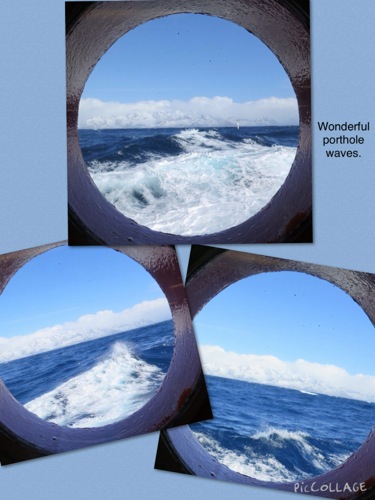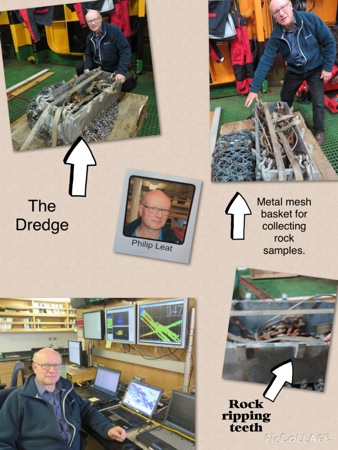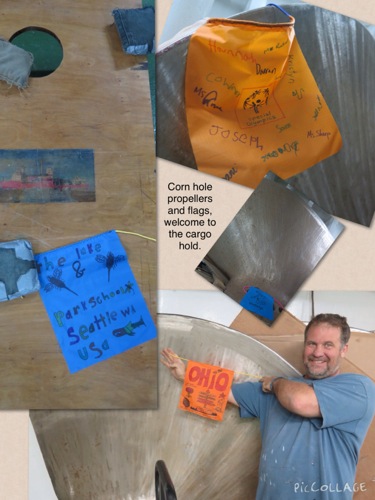Working at Sea!
Another glorious day on board the RV Palmer. The sky is a bright blue, and the winds, well they could be a little less than 40 knots. I have a time-lapse camera bungied and duct taped outside, and we will see later if I have any great pictures, or no camera at all.
 How can I not smile and be happy in 40 knot winds.
How can I not smile and be happy in 40 knot winds.
Today is a people day, a welcome to working with others at sea. I managed to catch up with a few groups of people, asked them some questions and am learning about careers at sea.
 While warm and snug in our 308 foot vessel I am still able to experience the excitement of high seas, wind, and still stay dry.
While warm and snug in our 308 foot vessel I am still able to experience the excitement of high seas, wind, and still stay dry.
On board the RV Palmer there are three main groups of people: those that work for Edison Chouest Offshore, the owners of the vessel. The ECO personnel include the captain, AB sailors, and galley staff. The ASC (Antarctic Support Contract) personnel are the crew that work more with the scientists, the MTs', the MLTs', and the ETs', to name a few. And then we have the scientific team.
My goal for a few days will be to highlight a few groups of these people and give you a glimpse into their background, job responsibilities, and roles on the vessel.
Hello Amy
 Say Hi to Amy Westman, our ship's Marine Lab Technician.
Say Hi to Amy Westman, our ship's Marine Lab Technician.
Amy is the Marine Lab Tech, the only one on the vessel and with a BS degree in marine science and a MS in oceanography. She is the perfect candidate for this position. The Marine Lab Tech has the responsibility of making sure the scientists have everything they need to complete their research. Amy is in charge of the labs on the vessel, trouble shooting the various bits of equipment in the lab, and even the shipping of materials from the vessel back to their home universities. For example, Phil is on board to collect the rocks we are hoping to dredge. It will be Amy's job to decode, fill out, and make sure the samples are correctly and safely sent back for the research to continue.
Hello Phil
 Meet Phil Leat, our British compliment and rock geochemist specialist.
Meet Phil Leat, our British compliment and rock geochemist specialist.
For the Marine Lab Tech to ship off samples, well then we need to collect some.
Let me introduce Phil. With a degree in geology and emphasis in
geochemistry Phil is the perfect rock man. It will be his job to
look at the samples we collect in the dredge and add another piece to
our South Georgia and Scotia Sea plate movement jig saw puzzle. With a
BS in Geology and his Ph.D, Phil specializes in looking at the
chemistry of lava, and specifically the Scotia Sea. When looking at
volcanic rocks, you can get the geologic history using geochemistry as a
tool. What I did not know was that as different plates move, sediments
move as well, and in these, elements: potassium, rubidium, and strontium,
to name a few, that transfer and change the chemical signature of the
lava. The scientific team is hoping to use the multi-beam data to find
a place to dredge, and get evidence as to the reason why the ranges on
South Georgia are three and a half times higher than similar rocks found
in Chile.
Hello Marcy and Steffen
 Who do you call to collect and decode data, the data busters, that's who... Marcy Davis and Steffen Saustrup
Who do you call to collect and decode data, the data busters, that's who... Marcy Davis and Steffen Saustrup
The scientific work aboard the RV Palmer is conducted by a well-oiled machine of professionals. For Phil to collect his rocks and have Amy ship them to America, Marcy and Steffen need to collect data for a suitable dredge location. Both Marcy and Steffen with respective BS degrees in geology and geophysics, acquire, process, and interpret the sea floor data. With over 37 years between the two, this cog in our ocean mapping team takes the electronic data that the equipment collects and gives it a face and meaning.
But wait... there is one more part to this daisy chain.
Hello Jeremy and Mackenzie - MTs (Marine Techs)
 Neither sleet not rain nor driving snow will stop Jeremy Lucke and Mackenzie Haberman from working on deck.
Neither sleet not rain nor driving snow will stop Jeremy Lucke and Mackenzie Haberman from working on deck.
Okay, let's make sure we have this correct. For Amy to mail the rocks to America, Phil has to collect rocks. Marcy and Ian use their data to select the location to dredge the rocks so that Jeremy and "Mac" need to make sure the dredge apparatus on deck is ready to go. Thus the marine techs are pivotal to get our process completed because without these rock samples, we would only be solving part of our Scotia Sea jigsaw puzzle. Both Mac and Jeremy are Marine Tech's and in charge of all back deck operations, which for this cruise is deployment of the dredge. This amazing team is also part of the MT staff of four that manages the seismic: both the streamer and the seismic gun. And wouldn't you know, with degrees in geochemistry and mechanical engineering, another invaluable team so that the process of science goes off without a hitch. When I asked Jeremy and Mac how they prepared for the variety of science that occurs on the RV Palmer they calmly said that about 25% is learned on the job -- flexibility is a must!
So there you have it, oh loyal readers, a small glimpse in the process of day-to-day science. Please know that I have barely touched on the amazing people aboard this vessel. And I hope to continue my daisy chain through the full human compliment until we reach the end, which might not happen because it takes a great many people to pull off a successful science cruise. But I am game and will work on adding in our people parts every day.
 Hi Seattle Lake and Park School with Eileen Hynes, and greetings to Ohio, Addison and Andrie Rose.
Hi Seattle Lake and Park School with Eileen Hynes, and greetings to Ohio, Addison and Andrie Rose.
Question for today: What is a catabatic wind? How might these winds effect us on the RV Palmer?


Comments